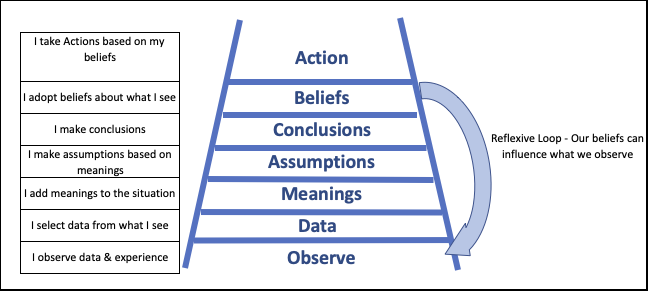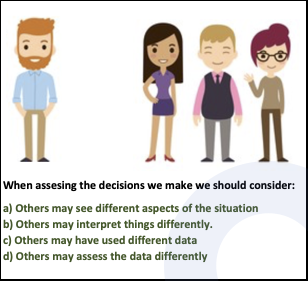
The Ladder of Inference is a model that describes the process or steps that we use to understand situations and decide on a course of action.
In this article, we will be discussing ladder, covering its key concepts, how it is applied together with an example of its’ use; this will include:
- What is the Ladder of inference
- Ladder of Inference steps
- How do we use the Ladder of Inference
- Jumping steps of the ladder
- Example of the Ladder of inference
- Benefits of the model
- Criticisms of the model
What is the ladder of inference?
The Ladder of Inference is a model that we can use to articulate decision making, how we move from data/information, experience, assumptions to a conclusion/action.
The model originates from “The Fifth Discipline: The Art and Practice of the Learning Organization” by Chris Argyris and Peter Senge.
Its principal purpose is as a reasoning process that helps to retain objectivity when thinking about an issue.
The ladder of inference considers the steps taken from receipt of information to decision making considering
- What assumptions exist
- Why do the assumptions exist
- How we interpret data and fact
- Questioning why beliefs exist
- Testing conclusions “Why am I taking this course of action?”
- Questioning what data is being utilized to solve the problem, and why has that been selected
As you can see, the model focuses on examining the situation and assumptions/actions. It has several characteristics:
- Endeavors to base reasoning on facts and reality
- Helps with analyzing situations & problems
- Helps avoid rash conclusions.
- Improves decision making through improved conclusions
- Helps with verifying conclusions
- Can aide with interpreting and analyzing information
- Can support challenging other peoples decision making
- Helps test statements
Problem-solving can invariably take many routes, including guessing at a solution or basing our actions on preconceived notions rather than fact.
This is especially true within a business environment where the climate can be fast-paced, and there is often a need to make decisions at speed.
This can lead to various issues such as:
- Guessing at a solution
- Relying on experience
- Rejecting team decision making
- Being selective over any data that is used
Most of us work within a team; in this situation, an inappropriate problem-solving strategy can lead to conflict with others who may have interpreted information differently and suggest a different course of action.
We can use the “Ladder of Inference” to help remedy this by being clear about:
- What steps might lead to you to incorrect conclusions
- What steps are fact-based and help describe an appropriate solution
Ladder of inference steps
The ladder contains a series of steps
- Observations
- Data / Selected reality
- Meanings/ Interpreted reality
- Assumptions
- Conclusions
- Beliefs
- Actions
These are illustrated by the graphic below:

The ladder describes a process in which we:
- Obtain information
- Experience these facts based on our own perspective (based on our experience and beliefs)
- Interpret these facts and what they mean to us
- Apply theories and assumptions to the situation
- Draw conclusions
- Develop beliefs based on these conclusions
- Develop a set of actions based on these beliefs.
As we can see, the model helps illustrate the point that our understanding of the situation we are in drives the decisions we make
This understanding may seem obvious to us; others, however, may have different understandings (and experience) and take alternative actions – this could be because:
- They may see different aspects of the situation
- They may interpret things differently.
- They may have used different data
- They may assess the data differently
Perhaps the key takeaway when utilizing the model is that it endeavors to focus on facts and data, enabling us to use our experiences positively rather than allowing them to lead our decision-making.
This approach *should* help avoid incorrect conclusions being made merely because we are considering the situation from our perspective.
How to use the Ladder of Inference
As described, the model uses a set of steps. The approach is as follows:
1/ Identify which stage of the ladder you are at. (Do not expect that you are at the beginning) – are you:
- Deciding on data to be used or how it should be used, or are you using your “reality,” i.e., a unique perception of the situation?
- Interpreting meaning in the issue being reviewed, which is likely to be independent of the data
- Making Assumptions?
- Questioning Assumptions?
- Building conclusions?
- Testing conclusions?
- Selecting actions?
2/ When you have assessed your existing position on the ladder, evaluate the reality that you have been utilizing. Review the previous steps, ask:
- What fact or information led you to a decision
- Why you came to a decision, you did.
- What assumptions have I made
- What facts/data have I used? Was it appropriate?
- Could I have chosen other conclusions?
- Were there specific beliefs that led to the course of action chosen?
- Do I think my conclusion is robust?
This approach may lead to you alter some assumptions or decisions.
Common questions at this stage include:
3/ Now work from the 1st step of the ladder. Work step by step using appropriate reasoning and use of data/facts. Applying appropriate questions (as above) throughout.
Key Concepts
- Recognize that conclusions are born out of information, the situation & perspective,
- Assume that conclusions may have errors that you don’t see
- Use data/information carefully:
- Use examples to illustrate your conclusions
- Explain how the data used and its meanings result in the conclusion you have made
- Be mindful that you may be selective over the data to drive the decisions you want to see
- Ask others if they see the data the same way and how they might use it to draw conclusions
- Use others to spot gaps in your thinking
- Assume that others may see things differently
- Ask others to explain the steps that they have taken in reaching the conclusions they have
- Review the context around the conclusion from the data used.
Jumping steps of the ladder
It’s a common issue that we may skip elements of the ladder when our judgments seem obviously correct to us.
We can see that this approach is fraught and can be based on poor judgment.

Jumping steps of the ladder may result in:
- Viewing the conclusions of others as obviously incorrect
- Not feel the need to express why we have selected the conclusion (as, to us, it is obviously correct)
- We may draw incorrect conclusions about why others have chosen alternative views
- May drive difficulty in resolving different perspectives resulting in conflict with others.
Example of the ladder of inference
Example 1 – No Milk in the refrigerator
Reality & Facts
Sue has got home from work and is looking to cook herself a meal. A key ingredient is milk. She goes to the refrigerator, but the milk that was there in the morning has gone, which means that she cannot prepare her meal.
The data: The lack of milk in the refrigerator
Selected reality: Sue’s husband Mark often uses things from the refrigerator and fails to replace them.
Assumptions Mark has used the milk.
Conclusion: Sue blames her husband, Mark, for using the milk and not replacing it.
The reality of this situation is that the carton of milk had cracked, causing the milk to leak out over the refrigerator spoiling various other items. On seeing this, Mark had thrown the items in the trash, saying to himself that he would stop at the store on the way home from work to replace them.
Mark had left a note on the table explaining the situation. Sue had missed this, thereby missing an essential piece of data in her decision-making.
Given the above example, can you see how Sue had skipped steps on the ladder and used her previous experiences to form her conclusion over the current situation? What could she have done differently by applying the ladder?
Example 2 – Late project delivery
Reality & Facts
Tom, the Company Manager, sees in his company report that Project Alpha has not been delivered as planned, impacting the customer.
The data
The company performance report
The conclusion
Colin, the project manager, should be reprimanded.
In this example, Tom has skipped steps on the ladder and jumped to a harsh conclusion.
Let’s examine Tom’s approach: he has:
a) Assessed information
b) Focused on one project
c) Seen the project was late
d) Assumed that this was entirely down to Colins performance
e) These assumed facts have reinforced held beliefs about Colins ability
f) Tom has reached the conclusion the Colin should be reprimanded
Tom has taken his own beliefs and assumptions into this process, and therefore, his actions are tainted
- Tom has reviewed the data based on a preconceived notion that Colin is not a good project manager
- He focused on Colin’s results due to this adversarial relationship
- Facts have been selected that reinforce beliefs.
We can use the Ladder of Inference to challenge this assessment and choice of action.
- Colin has delivered the project late, but if we look at the other projects within the program portfolio, 90% have been delivered late.
- Colin’s project is not in the worst position.
- Colin’s project has been affected by access to key resources within the company that was prioritized towards other activities leaving Colin insufficient resources to undertake the task.
- Colin has actually been effective and used stakeholder management to get the team he did have to work overtime to minimize the impact.
- Colin kept the customer aware of the revised delivery date, which helped minimize a potentially adversarial relationship.
- Tom needs to focus on resource planning within the company, which is the real root cause of the delays.
- Tom can use the learning in Colin’s project to help other project managers within the company.
As you can see through improved analysis of facts and challenging beliefs, a different outcome is achieved.
Benefits of Ladder of Inference
- It can be used at any stage of your thinking process.
- It is relatively simple to apply
- It incorporates the understanding of perspective into decision making and why this can lead to incorrect conclusions
- It can challenge assumptions
- It can review the use of facts in decision making
- It helps avoid jumping to conclusions
- In a team environment, it can help reduce conflict by providing transparency in decision making
Criticisms of Ladder of Inference
- The ladder of inference cannot always prevent a bad decision from being made (it merely highlights potential flaws in the decision-making process).
- Individuals are inherently flawed at assessing information and data.
- They cannot assess data from all the angels.
- They may not be aware of all available information.
- It does not remove conflict.
- It is human nature to use experience and personal beliefs in decision-making.
Summary
The Ladder of Inference is an interesting perspective on the process of decision-making and how we utilize our own personal beliefs and perspectives.
From the above, I’m sure we can all see times where we ourselves have skipped steps in the process because of preconceived beliefs.
Asking ourselves why decisions have been made is key to ensuring that the actions we take have robust foundations.
What are your thoughts on the model? As ever, we’d love your feedback.
You can reach us at @sanbustrain or via the comments section below.
This article is part of our Career Skills Guide